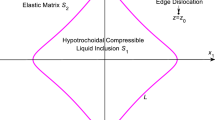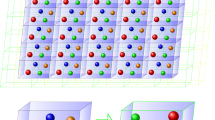Abstract
The notion of dynamic inclusion can be utilized to represent phenomena in micromechanics of solids such as phase transformations, in particular when subjected to dynamic loading. If the size of a dynamic inclusion is comparable to the inherent length parameters of its constituent material, then the size effect manifests its significance. The present paper is, hence, dedicated to the employment of the complete form of Mindlin’s first strain gradient theory of elasticity to address a special class of dynamic inclusion problems. Specifically, in this paper, an analytical solution is obtained for the elastic displacement field developed in an infinitely extended isotropic medium due to a suddenly expanding spherical inclusion that undergoes a constant and uniform distribution of classical dilatational eigenstrains. The employment of such a theoretical framework results in eliminating the classical singularities of the strain and stress fields of the problem. The analysis presented in this paper can, moreover, account for the effect of microinertia on the response of the medium to the sudden expansion of the inclusion, by incorporating an additional characteristic length into the equation of motion of the medium. An extended version for Hadamard conditions associated with the adopted theory is also derived, and subsequently, it is shown that the obtained solution of the considered problem satisfies these conditions.






Similar content being viewed by others
References
Cosserat, E., Cosserat, F.: Théorie des corps déformables. Hermann et Fils, Paris (1909)
Eringen, A.C.: Mechanics of micromorphic materials. In: Görtler, H. (ed.) Applied Mechanics. Springer, Berlin (1966)
Mindlin, R.D.: Micro-structure in linear elasticity. Arch. Ration. Mech. Anal. 16, 51–78 (1964)
Toupin, R.A.: Elastic materials with couple-stresses. Arch. Ration. Mech. Anal. 11(1), 385–414 (1962)
Mindlin, R.D., Eshel, N.N.: On first strain-gradient theories in linear elasticity. Int. J. Solids Struct. 4, 109–124 (1968)
Mindlin, R.D.: Second gradient of strain and surface-tension in linear elasticity. Int. J. Solids Struct. 1(4), 417–438 (1965)
Aifantis, E.C.: On the role of gradients in the localization of deformation and fracture. Int. J. Eng. Sci. 30(10), 1279–1299 (1992)
Ru, C.Q., Aifantis, E.C.: A simple approach to solve boundary-value problems in gradient elasticity. Acta Mech. 101(1–4), 59–68 (1993)
Altan, B.S., Aifantis, E.C.: On some aspects in the special theory of gradient elasticity. J. Mech. Behav. Mater. 8(3), 231–282 (1997)
Milligan, W.W., Hackney, S.A., Aifantis, E.C.: Constituive modeling for nanostructured materials. In: Muhlhaus, H. (Ed.), Continuum Models for Materials with Microstructures, chap. 11, pp. 379–394. Wiley (1995)
Lazar, M., Maugin, G.A.: Nonsingular stress and strain fields of dislocations and disclinations in first strain gradient elasticity. Int. J. Eng. Sci. 43(13), 1157–1184 (2005)
Lazar, M.: On gradient field theories: gradient magnetostatics and gradient elasticity. Phil. Mag. 94(25), 2840–2874 (2014)
Lazar, M.: A non-singular continuum theory of point defects using gradient elasticity of bi-Helmholtz type. Phil. Mag. 99(13), 1563–1601 (2019)
Mura, T.: Micromechanics of Defects in Solids, 2nd edn. Martinus Nijhoff, Dordrecht (1987)
Zhang, X., Sharma, P.: Inclusions and inhomogeneities in strain gradient elasticity with couple stresses and related problems. Int. J. Solids Struct. 42(13), 3833–3851 (2005)
Gao, X.L., Ma, H.M.: Green’s function and Eshelby’s tensor based on a simplified strain gradient elasticity theory. Acta Mech. 207(3–4), 163–181 (2009)
Delfani, M.R., Latifi Shahandashti, M.: Elastic field of a spherical inclusion with non-uniform eigenfields in second strain gradient elasticity. Proc. Roy. Soc. A Math. Phys. Eng. Sci. 473(2205), 20170254 (2017)
Sidhardh, S., Ray, M.C.: Inclusion problem for a generalized strain gradient elastic continuum. Acta Mech. 229(9), 3813–3831 (2018)
Ma, H., Hu, G., Wei, Y., Liang, L.: Inclusion problem in second gradient elasticity. Int. J. Eng. Sci. 132, 60–78 (2018)
Delfani, M.R., Sajedipour, M.: Spherical inclusion with time-harmonic eigenfields in strain gradient elasticity considering the effect of micro inertia. Int. J. Solids Struct. 155, 57–64 (2018)
Mikata, Y., Nemat-Nasser, S.: Elastic field due to a dynamically transforming spherical inclusion. J. Appl. Mech. 57, 845–849 (1990)
Cheng, Z.Q., Batra, R.C.: Exact Eshelby tensor for a dynamic circular cylindrical inclusion. J. Appl. Mech. 66, 563–565 (1999)
Michelitsch, T.M., Gao, H., Levin, V.M.: Dynamic Eshelby tensor and potentials for ellipsoidal inclusions. Proc. Roy. Soc. Lond. Ser. A Math. Phys. Eng. Sci. 459(2032), 863–890 (2003)
Sarvestani, A.S., Shodja, H.M., Delfani, M.R.: Determination of the scattered fields of an SH-wave by an eccentric coating-fiber ensemble using DEIM. Int. J. Eng. Sci. 46(11), 1136–1146 (2008)
Shodja, H.M., Delfani, M.R.: 3D elastodynamic fields of non-uniformly coated obstacles: Notion of eigenstress and eigenbody-force fields. Mech. Mater. 41(9), 989–999 (2009)
Wang, J., Michelitsch, T.M., Gao, H.: Dynamic fiber inclusions with elliptical and arbitrary cross-sections and related retarded potentials in a quasi-plane piezoelectric medium. Int. J. Solids Struct. 40(23), 6307–6333 (2003)
Xiao, Z.M., Luo, J.: On the transient elastic field for an expanding spherical inclusion in 3-D solid. Acta Mech. 163(3–4), 147–159 (2003)
Markenscoff, X., Ni, L.: The energy-release rate and “self-force” of dynamically expanding spherical and plane inclusion boundaries with dilatational eigenstrain. J. Mech. Phys. Solids 58(1), 1–11 (2010)
Ni, L., Markenscoff, X.: On self-similarly expanding Eshelby inclusions: Spherical inclusion with dilatational eigenstrain. Mech. Mater. 90, 30–36 (2015)
Ni, L., Markenscoff, X.: The dynamic generalization of the Eshelby inclusion problem and its static limit. Proc. Roy. Soc. A Math. Phys. Eng. Sci. 472(2191), 20160256 (2016)
Ni, L., Markenscoff, X.: The self-similarly expanding Eshelby ellipsoidal inclusion: I. Field solution. J. Mech. Phys. Solids 96, 683–695 (2016)
Ni, L., Markenscoff, X.: The self-similarly expanding Eshelby ellipsoidal inclusion: II. The Dynamic Eshelby Tensor for the expanding sphere. J. Mech. Phys. Solids 96, 696–714 (2016)
Yang, S.Y., Escobar, J., Clifton, R.J.: Computational modeling of stress-wave-induced martensitic phase transformations in NiTi. Math. Mech. Solids 14(1–2), 220–257 (2009)
Backus, G., Mulcahy, M.: Moment tensors and other phenomenological descriptions of seismic sources-I. Continuous displacements. Geophys. J. Int. 46(2), 341–361 (1976)
Markenscoff, X.: Self-similarly expanding regions of phase change yield cavitational instabilities and model deep earthquakes. J. Mech. Phys. Solids 127, 167–181 (2019)
Lazar, M., Po, G.: On Mindlin’s isotropic strain gradient elasticity: green tensors, regularization, and operator-split. J. Micromech. Mol. Phys. 3(3&4), 1840008 (2018)
Po, G., Admal, N.C., Lazar, M.: The Green tensor of Mindlin’s anisotropic first strain gradient elasticity. Mater. Theory 3(1), 3 (2019)
Delfani, M.R., Tavakol, E.: Uniformly moving screw dislocation in strain gradient elasticity. Eur. J. Mech. A Solids 73, 349–355 (2019)
Delfani, M. R., Taaghi, S., Tavakol, E.: Uniform motion of an edge dislocation within Mindlin’s first strain gradient elasticity. Int. J. Mech. Sci. 105701 (2020)
Lazar, M.: Incompatible strain gradient elasticity of Mindlin type: screw and edge dislocations. Acta Mech. 232(9), 3471–3494 (2021)
Nazarenko, L., Glüge, R., Altenbach, H.: Positive definiteness in coupled strain gradient elasticity. Cont. Mech. Thermodyn. 33(3), 713–725 (2021)
Askes, H., Aifantis, E.C.: Gradient elasticity in statics and dynamics: an overview of formulations, length scale identification procedures, finite element implementations and new results. Int. J. Solids Struct. 48(13), 1962–1990 (2011)
Gourgiotis, P.A., Georgiadis, H.G.: Torsional and SH surface waves in an isotropic and homogenous elastic half-space characterized by the Toupin-Mindlin gradient theory. Int. J. Solids Struct. 62, 217–228 (2015)
Shodja, H.M., Goodarzi, A., Delfani, M.R., Haftbaradaran, H.: Scattering of an anti-plane shear wave by an embedded cylindrical micro-/nano-fiber within couple stress theory with micro inertia. Int. J. Solids Struct. 58, 73–90 (2015)
Lazar, M., Anastassiadis, C.: Lie point symmetries, conservation and balance laws in linear gradient elastodynamics. J. Elast. 88(1), 5–25 (2007)
Willis, J.R.: Dislocations and inclusions. J. Mech. Phys. Solids 13(6), 377–395 (1965)
Lazar, M., Agiasofitou, E., Böhlke, T.: Mathematical modeling of the elastic properties of cubic crystals at small scales based on the Toupin-Mindlin anisotropic first strain gradient elasticity. Cont. Mech. Thermodyn. (2021). https://doi.org/10.1007/s00161-021-01050-y
Eringen, A.C., Edelen, D.G.B.: On nonlocal elasticity. Int. J. Eng. Sci. 10(3), 233–248 (1972)
Altan, S.B., Aifantis, E.C.: On the structure of the mode III crack-tip in gradient elasticity. Scr. Metall. Mater. 26(2), 319–324 (1992)
Author information
Authors and Affiliations
Corresponding author
Ethics declarations
Conflict of interests
The authors declare that they have no conflict of interest.
Additional information
Communicated by Andreas Öchsner.
Publisher's Note
Springer Nature remains neutral with regard to jurisdictional claims in published maps and institutional affiliations.
Appendix
Appendix
This appendix is dedicated to the determination of the unknown functions \(\Theta _0(r)\) and \(\Theta _1(r;t)\) by solving differential equations (34a) and (34b). It is desired here to use the method of Green’s function for such a purpose. To this end, let us first consider Eq. (34a), and suppose that \({\mathscr {G}}_0(r,r')\) denotes its associated Green’s functions. Then, it can be shown that multiplying both sides of that equation by \(r^2\,{\mathscr {G}}_0(r,r')\) followed by integrating them from 0 to \(\infty \) with respect to r gives rise to
If the second integral on the left-hand side of the above equation is expanded by integration by parts twice, this equation can be rewritten as

Now, let us suppose that the Green’s function \({\mathscr {G}}_0(r,r')\) is the solution of the following equation,
and satisfies the conditions,
Accordingly, one can readily conclude from Eq. (A-2) that
Hence, the determination of the expression for \(\Theta _0(r)\) requires to obtain the solution of the Green’s function. To this end, let us re-express Eq. (A-3) as
Then, it is appropriate to consider the following general expressions for the solution of the above equation.
where \(A_1\), \(A_2\), \(A_3\), and \(A_4\) are unknown constants that must be determined by applying a set of proper conditions. First of all, note that the Green’s function \({\mathscr {G}}_0(r,r')\) must have bounded values over its entire domain, particularly at \(r=0\) and \(\infty \). Thus,
Let us mention here that setting \(A_3=0\) satisfies both conditions given by Eqs. (A-4a) and (A-4b). Moreover, note that the Green’s function \({\mathscr {G}}_0(r,r')\) must be continuous at \(r=r'\). The latter condition in view of the expressions given by Eq. (A-7) and using Eqs. (A-8) results in
Furthermore, by integrating both sides of Eq. (A-3) from \(r'-\delta r'\) to \(r'+\delta r'\) with respect to r and, then, taking their limits as \(\delta r'\rightarrow 0^+\), it is obtained that
After evaluating the second integral on the left-hand side of the above equation in conjunction with expanding the last integral by integration by parts, one can write
With due attention to the continuity of the Green’s function \({\mathscr {G}}_0(r,r')\) at \(r=r'\), the above equation reduces to
Thereafter, using Eqs. (A-7) and (A-8), it can be shown that
Then, solving Eqs. (A-9) and (A-13) for \(A_1\) and \(A_4\) leads to
Using the above results together with Eqs. (A-8), the Green’s function \({\mathscr {G}}_0(r,r')\) takes the following final form.
Subsequently, by the substitution of the expression for \({\mathscr {G}}_0(r,r')\) from the above equation into Eq. (A-5), it is obtained that
Likewise, it can be shown that the Green’s function problem corresponding to Eq. (34b) is expressible as
where \({\mathscr {G}}_1(r,r';t)\) is the Green’s function associated with the function \(\Theta _1(r;t)\). The Green’s function \({\mathscr {G}}_1(r,r';t)\) must, similarly, be continuous at \(r=r'\), and it must also have a bounded value at \(r=0\). Furthermore, it must vanish at \(r=R_{\mathrm{m}}(t)\), where \(R_{\mathrm{m}}(t)\) has formerly been defined by Eq. (35). By applying these conditions to Eq. (A-17), the below-given solution is, thus, obtained for \({\mathscr {G}}_1(r,r';t)\).
Now, the function \(\Theta _1(r;t)\) can similarly be obtained in terms of its associated Green’s function via
Subsequently, by substituting Eq. (A-18) into the above integral, it can be shown that
Rights and permissions
About this article
Cite this article
Delfani, M.R., Tarvirdilu-Asl, A. & Sajedipour, M. Elastic fields due to a suddenly expanding spherical inclusion within Mindlin’s first strain-gradient theory. Continuum Mech. Thermodyn. 34, 697–719 (2022). https://doi.org/10.1007/s00161-022-01084-w
Received:
Accepted:
Published:
Issue Date:
DOI: https://doi.org/10.1007/s00161-022-01084-w




